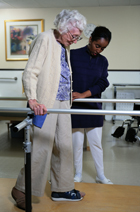
Medicare. Medicaid. Healthcare reform. Long-term care providers were bombarded with a lot of big stories this week. One topic that is at risk of being overlooked, however, is new research on falls.
A new study from the Agency for Healthcare Research and Quality found that elderly adults had more than 2.1 million emergency department visits for injurious falls in 2006. These accounted for 1 in 10 ED visits among patients aged 65 and older.
The AHRQ report also said that elderly patients seen in the ED for injurious falls and then admitted to the hospital were more likely to go to long-term care facilities than ED patients admitted to the hospital with other conditions. (For more, see the story here.)
Along with Medicare and Medicaid, falls represent one of the biggest concerns for nursing home providers. They are a major reason why residents are admitted to nursing homes and have to stay there. If not treated properly, they can lead to other serious conditions, such as pressure ulcers.
Which is why another story about a study from the British Medical Journal grabbed readers’ notice. An analysis of studies posted in the journal last Friday found that a larger dose of vitamin D better helps to prevent falls among those 65 and older than a dose recommended by the U.S. Institute of Medicine. The analysis recommends seniors take 700 to 1,000 international units (IU) of vitamin D per day.
The research is a reason to revisit the U.S. recommendations, according to the director of the Center on Aging and Mobility at the University of Zurich, Reuters reported.
While it’s easy to get caught up in issues of funding and legislation, it is clinical subjects—direct caregiving issues—that deserve as much, if not more of providers’ attention.




